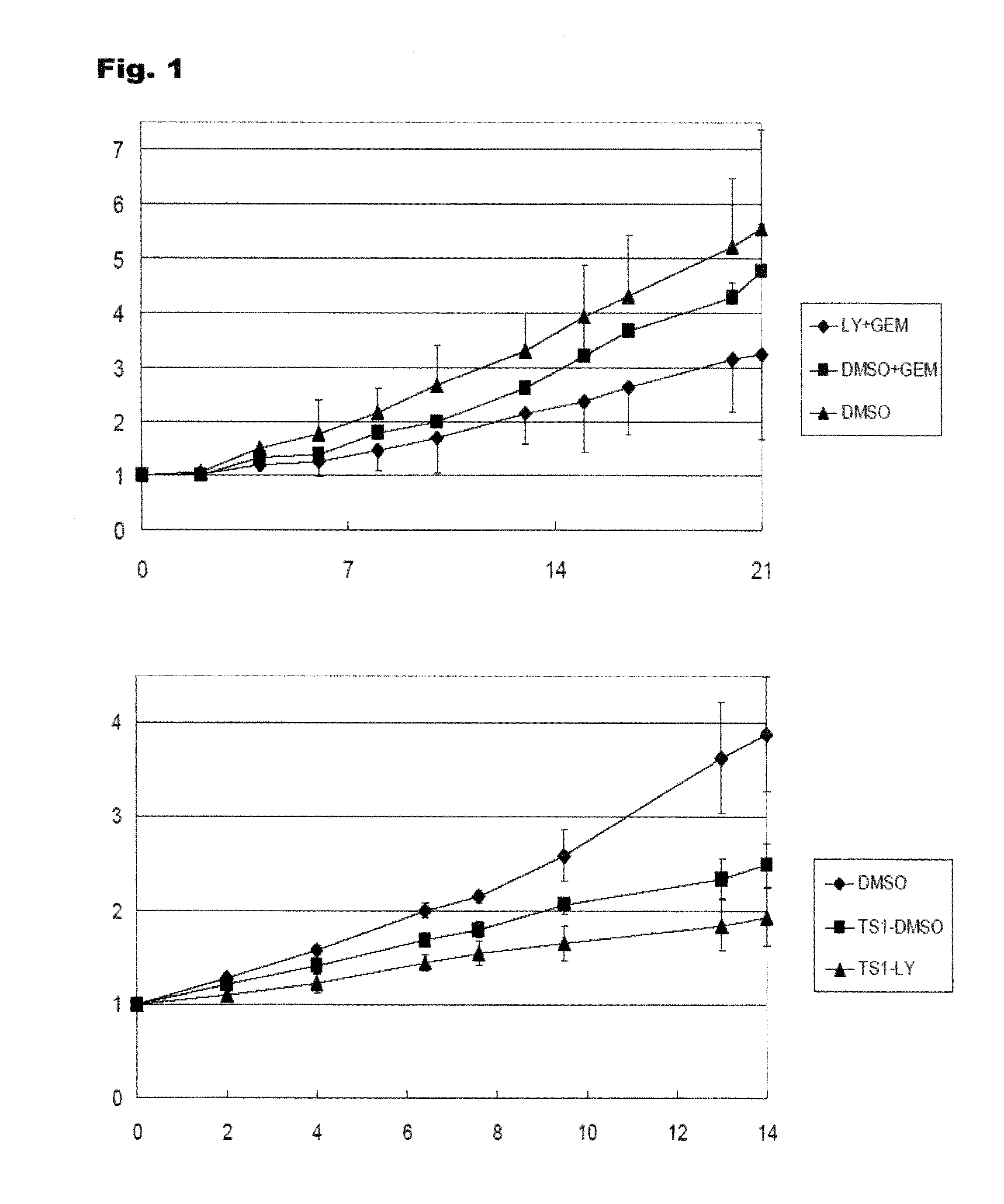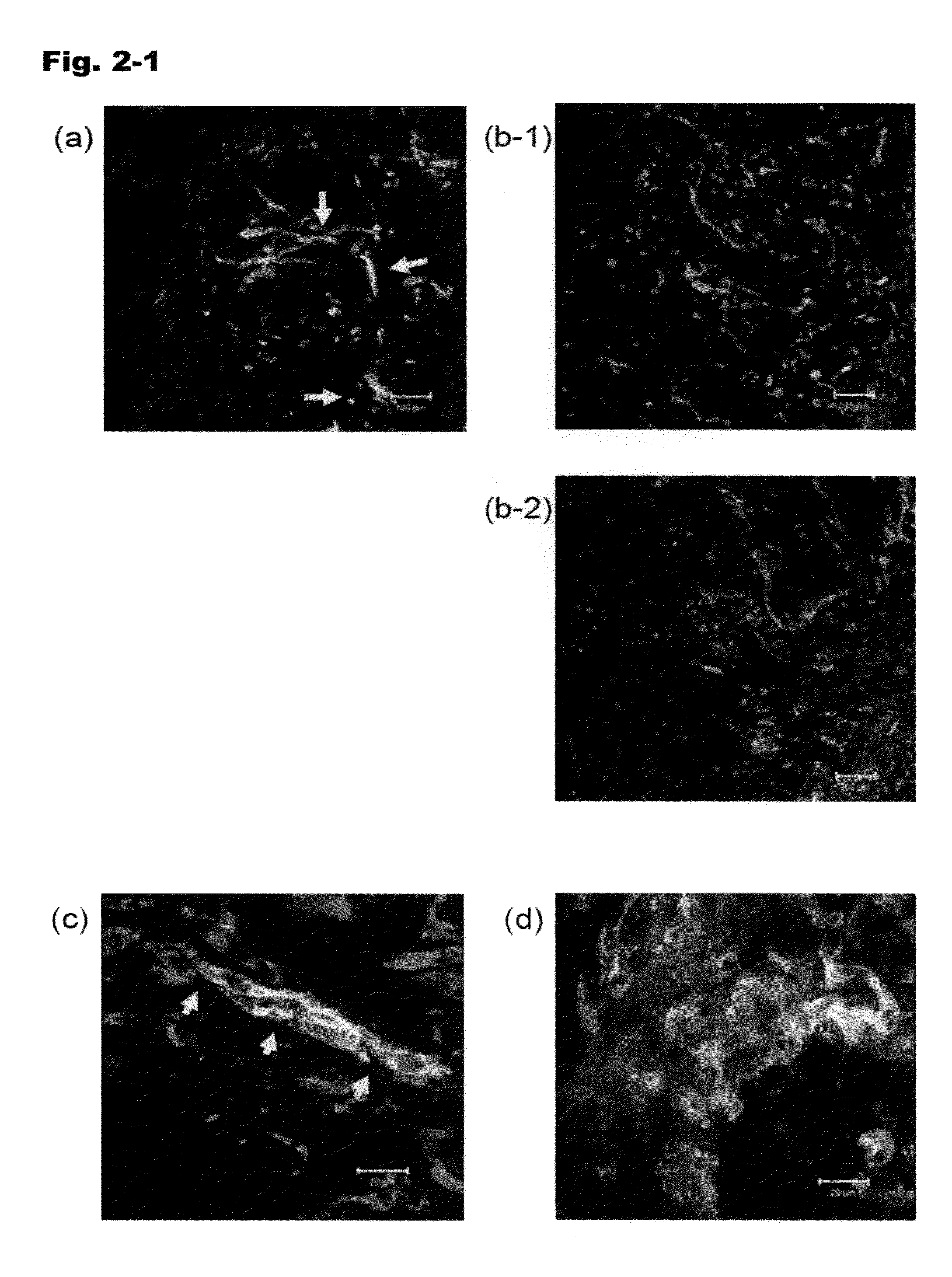Combined use of tgf-b signaling inhibitor and antitumor agent
a signaling inhibitor and antitumor technology, applied in the direction of antibody medical ingredients, peptide/protein ingredients, therapy, etc., can solve the problems of insufficient therapeutic effect of existing chemotherapeutic agents but also the above drug-encapsulating macromolecular micelles, no established view on whether, and difficulty in treating, so as to reduce fibrosis and increase the leakiness of the neovascular structure.
- Summary
- Abstract
- Description
- Claims
- Application Information
AI Technical Summary
Benefits of technology
Problems solved by technology
Method used
Image
Examples
example 1
Combined Effect of a General Anticancer Agent (Unmodified) and a TGF-β Signaling Inhibitor in Pancreatic Adenocarcinoma Model
[0078]Drug: Gemcitabine
[0079]Method:
[0080]Four weeks-old male nude mice were subcutaneously injected in the abdominal wall with 5×106 counts of Smad-4-deficient pancreatic adenocarcinoma cells (BxPC3: ATCC No. CRL-1687), and when approximately two weeks have elapsed from the transplantation, those in which the cancer cell mass entered a proliferative phase were used in the experiment as xenograft models of pancreatic adenocarcinoma. Combining Gemcitabine (hereinafter, abbreviated as Gem), administrated twice a week intraperitoneally at 125 mg / kg, and LY364947 (hereinafter, referred to as LY), administrated three times a week intraperitoneally at 1 mg / kg, three groups were established as follows: a control group, a Gem alone administration group and a LY+Gem combined application group, with n=2 each. For these animals, the values of the tumor volume were observ...
example 2
Effects of TGF-β Signaling Inhibitor on Neovasculature by Matrigel Plug Assay
[0088]Method:
[0089]VEGF-A, FGF-2, and heparin were mixed into Matrigel (BD), furthermore, 500 nM of the TGF-β inhibitor LY364947 (hereinafter, referred to as LY) or 50 μg / ml of T βRII:Fc or a control was further mixed into the same gel, these were subcutaneously injected into the abdominal wall of male ICR mice, the animals were sacrificed on the 7th day to extract the Matrigel plug, and a search was carried out using immunofluorescence staining. Concretely, regarding the neovasculature morphology, vascular endothelial cells were recognized with an antibody against PECAM-1 (platelet endothelial cell adhesion molecule-1) and vascular pericytes were recognized with an antibody against SMA (a smooth muscle actin), in the LY-administered group or control group, the proportion of the areas covered by pericytes within the total endothelial cell area, and, the areas positive for the vascular endothelium marker wer...
example 3
Combined Application of Macromolecular Compound and TGF-β Signaling Inhibitor
3-1. Smad-4-Deficient TGF-β Signaling-Non-Responsive Pancreatic Adenocarcinoma Cell (BxPC3)-High Molecular Weight Dextran-LY364947, Neovasculature Morphological Change and Dextran Distribution
[0092]Method:
[0093]Four weeks-old male nude mice were subcutaneously injected in the abdominal wall with 5×106 counts of Smad-4-deficient pancreatic adenocarcinoma cells (BxPC3), and when approximately two weeks have elapsed from the transplantation, those in which the cancer cell mass entered a proliferative phase were used in the experiment as xenograft models of pancreatic adenocarcinoma. Twenty-four hours before sacrificing the animals, 1 mg / kg of LY364947 (hereinafter, referred to as LY) as TGF-β inhibitor or a control was administered once intraperitoneally. The animals were sacrificed to extract the tumor mass, and a histological search was performed. Concretely, regarding the neovasculature morphology, vascular...
PUM
| Property | Measurement | Unit |
|---|---|---|
| molecular weight | aaaaa | aaaaa |
| permeability | aaaaa | aaaaa |
| binding affinity | aaaaa | aaaaa |
Abstract
Description
Claims
Application Information
 Login to View More
Login to View More - R&D
- Intellectual Property
- Life Sciences
- Materials
- Tech Scout
- Unparalleled Data Quality
- Higher Quality Content
- 60% Fewer Hallucinations
Browse by: Latest US Patents, China's latest patents, Technical Efficacy Thesaurus, Application Domain, Technology Topic, Popular Technical Reports.
© 2025 PatSnap. All rights reserved.Legal|Privacy policy|Modern Slavery Act Transparency Statement|Sitemap|About US| Contact US: help@patsnap.com



